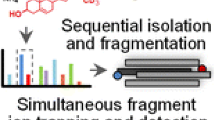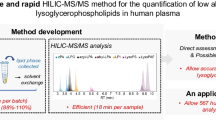Abstract
Monitoring the levels of the ceramides (Cer) d18:1/16:0, Cer d18:1/18:0, Cer d18:1/24:0, and Cer d18:1/24:1 and ratios thereof in human plasma empowers the prediction of fatal outcome of coronary artery disease (CAD). We describe a validated liquid chromatography–tandem mass spectrometry (LC–MS/MS) methodology for clinical-scaled measurement of the four distinct ceramides. Rapid plasma precipitation was accomplished in 96-well format. Excellent extraction recoveries in the range of 98–109 % were achieved for each ceramide. Addition of corresponding D7-labeled ceramide standards facilitated precise quantification of each plasma ceramide species utilizing a novel short 5-min LC–MS/MS method. Neither matrix interference nor carryover was observed. Robust intra- and inter-assay accuracy and precision <15 % at five different concentrations were obtained. Linear calibration lines with regressions, R 2 > 0.99, were achieved for all analytes. Short-term bench top, long-term plasma, and extract stability demonstrated that the distinct ceramides were stable in the conditions evaluated. The validity of the methodology was demonstrated by determining the precise ceramide concentrations in a small CAD case–control study. Thus, our LC–MS/MS methodology features simple sample preparation and short analysis time for accurate quantification of Cer d18:1/16:0, Cer d18:1/18:0, Cer d18:1/24:0, and Cer d18:1/24:1, designed for routine analysis.

Workflow of molecular ceramide analysis




Similar content being viewed by others
References
Maceyka M, Spiegel S. Sphingolipid metabolites in inflammatory disease. Nature. 2014;510:58–67.
Tarasov K, Ekroos K, Suoniemi M, Kauhanen D, Sylvänne T, Hurme R, et al. Molecular lipids identify cardiovascular risk and are efficiently lowered by simvastatin and PCSK9 deficiency. J Clin Endocrinol Metab. 2014;99:E45–52.
Haynes CA, Allegood JC, Park H, Sullards MC. Sphingolipidomics: methods for the comprehensive analysis of sphingolipids. J Chromatogr B Analyt Technol Biomed Life Sci. 2009;877:2696–708.
Mullen TD, Hannun YA, Obeid LM. Ceramide synthases at the centre of sphingolipid metabolism and biology. Biochem J. 2012;441:789–802.
Merrill AH. Sphingolipid and glycosphingolipid metabolic pathways in the era of sphingolipidomics. Chem Rev. 2011;111:6387–422.
Dobrzyń A, Górski J. Ceramides and sphingomyelins in skeletal muscles of the rat: content and composition. Effect of prolonged exercise. Am J Physiol Endocrinol Metab. 2002;282:E277–85.
Previati M, Bertolaso L, Tramarin M, Bertagnolo V, Capitani S. Low nanogram range quantitation of diglycerides and ceramide by high-performance liquid chromatography. Anal Biochem. 1996;233:108–14.
Vielhaber G, Brade L, Lindner B, Pfeiffer S, Wepf R, Hintze U, et al. Mouse anti-ceramide antiserum: a specific tool for the detection of endogenous ceramide. Glycobiology. 2001;11:451–7.
Samuelsson K, Sameulsson B. Gas chromatographic and mass spectrometric studies of synthetic and naturally occurring ceramides. Chem Phys Lipids. 1970;5:44–79.
Liebisch G, Drobnik W, Reil M, Trümbach B, Arnecke R, Olgemöller B, et al. Quantitative measurement of different ceramide species from crude cellular extracts by electrospray ionization tandem mass spectrometry (ESI-MS/MS). J Lipid Res. 1999;40:1539–46.
Simons B, Kauhanen D, Sylvänne T, Tarasov K, Duchoslav E, Ekroos K. Shotgun lipidomics by sequential precursor Ion fragmentation on a hybrid quadrupole time-of-flight mass spectrometer. Metabolites. 2012;2:195–213.
Breslow DK, Collins SR, Bodenmiller B, Aebersold R, Simons K, Shevchenko A, et al. Orm family proteins mediate sphingolipid homeostasis. Nature. 2010;463:1048–53.
Han X. Characterization and direct quantitation of ceramide molecular species from lipid extracts of biological samples by electrospray ionization tandem mass spectrometry. Anal Biochem. 2002;302:199–212.
Merrill AH, Sullards MC, Allegood JC, Kelly S, Wang E. Sphingolipidomics: high-throughput, structure-specific, and quantitative analysis of sphingolipids by liquid chromatography tandem mass spectrometry. Methods. 2005;36:207–24.
Bielawski J, Szulc ZM, Hannun YA, Bielawska A. Simultaneous quantitative analysis of bioactive sphingolipids by high-performance liquid chromatography-tandem mass spectrometry. Methods. 2006;39:82–91.
Jiang H, Hsu F-F, Farmer MS, Peterson LR, Schaffer JE, Ory DS, et al. Development and validation of LC-MS/MS method for determination of very long acyl chain (C22:0 and C24:0) ceramides in human plasma. Anal Bioanal Chem. 2013;405:7357–65.
US Department of Health and Human Services, Food and Drug Administration, Center for Drug Evaluation and Research and Center for Veterinary Medicine (2001) Guidance for Industry: Bioanalytical method validation. http://www.fda.gov/downloads/Drugs/Guidance/ucm070107.pdf
Vaara S, Nieminen MS, Lokki M-L, Perola M, Pussinen PJ, Allonen J, et al. Cohort profile: the corogene study. Int J Epidemiol. 2012;41:1265–71.
Ann Q, Adams J. Structure determination of ceramides and neutral glycosphingolipids by collisional activation of [M + Li]+ ions. J Am Soc Mass Spectrom. 1992;3:260–3.
Hsu F-F, Turk J. Characterization of ceramides by low energy collisional-activated dissociation tandem mass spectrometry with negative-ion electrospray ionization. J Am Soc Mass Spectrom. 2002;13:558–70.
Hsu F-F, Turk J, Stewart ME, Downing DT. Structural studies on ceramides as lithiated adducts by low energy collisional-activated dissociation tandem mass spectrometry with electrospray ionization. J Am Soc Mass Spectrom. 2002;13:680–95.
Schiller J, Arnhold J, Glander HJ, Arnold K. Lipid analysis of human spermatozoa and seminal plasma by MALDI-TOF mass spectrometry and NMR spectroscopy—effects of freezing and thawing. Chem Phys Lipids. 2000;106:145–56.
Li W, Tang Y, Guo J, Shang E, Qian Y, Wang L, et al. Comparative metabolomics analysis on hematopoietic functions of herb pair Gui-Xiong by ultra-high-performance liquid chromatography coupled to quadrupole time-of-flight mass spectrometry and pattern recognition approach. J Chromatogr A. 2014;1346:49–56.
Sonomura K, Kudoh S, Sato TA, Matsuda F. Plasma lipid analysis by hydrophilic interaction liquid chromatography coupled with electrospray ionization tandem mass spectrometry. J Sep Sci. 2015;38:2033–7.
Krishnamurthy K, Dasgupta S, Bieberich E. Development and characterization of a novel anti-ceramide antibody. J Lipid Res. 2007;48:968–75.
Scherer M, Schmitz G, Liebisch G. High-throughput analysis of sphingosine 1-phosphate, sphinganine 1-phosphate, and lysophosphatidic acid in plasma samples by liquid chromatography-tandem mass spectrometry. Clin Chem. 2009;55:1218–22.
Taylor RL, Grebe SK, Singh RJ. Quantitative, highly sensitive liquid chromatography-tandem mass spectrometry method for detection of synthetic corticosteroids. Clin Chem. 2004;50:2345–52.
Gold H, Mirzaian M, Dekker N, Ferraz MJ, Lugtenburg J, Codée JDC, et al. Quantification of globotriaosylsphingosine in plasma and urine of fabry patients by stable isotope ultraperformance liquid chromatography-tandem mass spectrometry. Clin Chem. 2013;59:547–56.
Müller MJ, Volmer DA. Mass spectrometric profiling of vitamin D metabolites beyond 25-hydroxyvitamin D. Clin Chem. 2015;61:1033–48.
Ng TWK, Ooi EMM, Watts GF, Chan DC, Meikle PJ, Barrett PHR. Association of plasma ceramides and sphingomyelin with VLDL apoB-100 fractional catabolic rate before and after rosuvastatin treatment. J Clin Endocrinol Metab. 2015;100:2497–501.
Xia JY, Holland WL, Kusminski CM, Sun K, Sharma AX, Pearson MJ, et al. Targeted induction of ceramide degradation leads to improved systemic metabolism and reduced hepatic steatosis. Cell Metab. 2015;22:266–78.
Perman JC, Boström P, Lindbom M, Lidberg U, StÅhlman M, Hägg D, et al. The VLDL receptor promotes lipotoxicity and increases mortality in mice following an acute myocardial infarction. J Clin Invest. 2011;121:2625–40.
Sampaio JL, Gerl MJ, Klose C, Ejsing CS, Beug H, Simons K, et al. Membrane lipidome of an epithelial cell line. Proc Natl Acad Sci U S A. 2011;108:1903–7.
Han X, Rozen S, Boyle SH, Hellegers C, Cheng H, Burke JR, et al. Metabolomics in early Alzheimer’s disease: identification of altered plasma sphingolipidome using shotgun lipidomics. PLoS One. 2011;6:e21643.
Acknowledgments
We thank Walt Shaw and Lisa Connell at Avanti Polar Lipids for their great support. We thank all members of our laboratory for valuable discussions and suggestions. The research leading to these results has received funding from the European Union’s Seventh Framework Programme FP7/2007-2013 under grant agreement no. 305739.
Author information
Authors and Affiliations
Corresponding author
Ethics declarations
Conflict of interest
The authors declare that there is no conflict of interest.
Electronic supplementary material
Below is the link to the electronic supplementary material.
ESM 1
(PDF 12 kb)
Rights and permissions
About this article
Cite this article
Kauhanen, D., Sysi-Aho, M., Koistinen, K.M. et al. Development and validation of a high-throughput LC–MS/MS assay for routine measurement of molecular ceramides. Anal Bioanal Chem 408, 3475–3483 (2016). https://doi.org/10.1007/s00216-016-9425-z
Received:
Revised:
Accepted:
Published:
Issue Date:
DOI: https://doi.org/10.1007/s00216-016-9425-z




